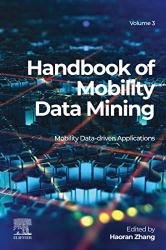 Название: Handbook of Mobility Data Mining, Vol. 1-3
Название: Handbook of Mobility Data Mining, Vol. 1-3Автор: Haoran Zhang
Издательство: Elsevier
Год: 2023
Страниц: 224+212+244
Язык: английский
Формат: pdf (true)
Размер: 17.8 MB
"Handbook of Mobility Data Mining" представляет фундаментальные технологии мобильного анализа больших данных (MDM), передовые методы искусственного интеллекта и приложения верхнего уровня, помогая читателям всесторонне понять MDM с подходом "снизу вверх". Книга объясняет, как предварительно обрабатывать мобильные большие данные, визуализировать городскую мобильность, моделировать и прогнозировать поведение людей в поездках, а также оценивать характеристики городской мобильности и их соответствие как условия и ограничения в системах транспорта, управления чрезвычайными ситуациями и устойчивого развития. Книга содержит важную информацию для исследователей, инженеров, операторов, администраторов и политиков, стремящихся лучше понять структуру и ограничения современных технологий.
Mobility Data Mining (MDM) is a novel research and business field supported by the growth in smartphone use. MDM can help breed new digital, data-driven services that use several technological capabilities associated with intelligent mobility innovation. It relies on building an ecosystem of stakeholders that agree to manage the supply and demand of the services that travelers want, such as intelligent transportation systems, smart emergency management, sustainability development innovates, etc.
MDM is an emerging topic both in academic and industrial aspects. Currently, all studies about mobile big data mining are fragmented. Few works have summarized the systemic knowledge on this field. Specifically, there is no book focusing on introducing how to screen and process the potential value from “deluge” of unverified, noisy, and sometimes incomplete information of mobile big data. Also, few works comprehensively summarized frontier applications of MDM technologies. However, the above knowledge is significant for stakeholders, such as researchers, engineers, operators, company administrators, and policymakers in related fields, to comprehensively understand current technologies’ infra-knowledge structure and limitations. Therefore, we planned to write a series of books mainly focusing on these issues.
The readers of this book can find the knowledge of how to preprocess mobile big data, visualize urban mobility, simulate and predict human travel behavior, and assess the urban mobility characteristics and their matching performance as conditions and constraints in transport, emergency management, and sustainability development systems that are undergoing automation and are highly dependent on software, navigation systems, and connectivity. Further, this book will focus on introducing how to design MDM platforms that adapt to the evolving mobility environment, new types of transportation, and users based on an integrated solution that utilizes the sensing and communication capabilities to tackle the significant challenges that the MDM field faces.
The handbook includes three volumes:
Volume 1: Data Preprocessing and Visualization focuses on how to efficiently preprocess mobility big data to extract and utilize critical feature information of high-dimensional city people flow. It first provides a conceptual theory and framework, then goes on to discuss data sources, trajectory map matching, noise filtering, trajectory data segmentation, data quality assessment, and more. It concludes with a chapter on mobility big data visualization.
Volume 2: Mobility Analytics and Prediction provides a basis for how to simulate and predict mobility data. After an introductory theory chapter, it then covers crucial topics such as long-term mobility pattern analytics, mobility data generators, user information inference, grid-based population density prediction, and more. It concludes with a chapter on graph-based mobility data analytics.
Volume 3: Mobility Data-driven Applications looks at various case studies to illustrate and explore the methods introduced in the first two volumes. It begins with a set of chapters on intelligent transportation management, using cases of bicycle-sharing, ride-hailing, travel time prediction, railway usage analysis, mobility data-driven service, and dynamic road pricing. It concludes with chapters on urban sustainability development, including road emission and living environment inequity analysis.
Books:
1) Handbook of Mobility Data Mining, Volume 1: Data Preprocessing and Visualization
2) Handbook of Mobility Data Mining, Volume 2: Mobility Analytics and Prediction
3) Handbook of Mobility Data Mining, Volume 3: Mobility Data-Driven Applications
Скачать Handbook of Mobility Data Mining, Vol. 1-3